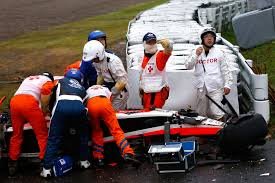
Jules Bianchi’s father Philippe has destroyed Formula 1 with race control showing no respect for his son’s memory, allowing a recovery vehicle. Today we will discuss about Jules Bianchi: Cause of death| Autopsy report| What happened to
Jules Bianchi: Cause of death| Autopsy report| What happened to
Jules Lucien André Bianchi (3 August 1989 – 17 July 2015) was a French motor racing driver who drove for the Marussia F1 team in the FIA Formula One World Championship.
| Born | Jules Lucien André Bianchi 3 August 1989 Nice, France |
|---|---|
| Died | 17 July 2015 (aged 25) Nice, France |
| Formula One World Championship career | |
| Nationality | |
| Active years | 2013–2014 |
| Teams | Marussia |
| Car number | 17 (retired in honour) |
| Entries | 34 (34 starts) |
| Championships | 0 |
| Wins | 0 |
| Podiums | 0 |
| Career points | 2 |
| Pole positions | 0 |
| Fastest laps | 0 |
| First entry | 2013 Australian Grand Prix |
| Last entry | 2014 Japanese Grand Prix |
| Related to |
|
Cause of death

Although Jules did not die from his injuries (he is in very serious condition with severe brain injury), his accident was avoidable and preventable, like many of the other driver injuries discussed here. The mechanism of Jules injury is discussed in the appropriate section below: Recession injuries.
Nine months after a horrific crash at the 2015 Japanese Grand Prix, Marussia F1 driver Jules Bianchi has died in a French hospital aged just 25. Bianchi’s death was the first death from running injuries since the death of Aryaton Senna. 1994 at the San Marino Grand Prix in Imola. The 21-year hiatus from Senna’s death to Bianchi was a safety record in F1 with no deaths, highlighting the danger involved in the sport.
Autopsy report

The family of Jules Bianchi has confirmed in a statement that the 25-year-old Marussia driver suffered a “diffuse axonal injury” to the head in his massive crash during the Japanese Grand Prix, where he veered off the path and collided with a recovery vehicle. Gone.
A diffuse axial injury is one of the most common types of traumatic brain injury, with ’90 percent of victims not awake’.
According to medical journals, a diffuse axial injury (DAI) is a common result of a traumatic acceleration/deceleration or rotational injury.
They are a frequent cause of a persistent vegetative state in patients and are a common injury suffered by victims of high-speed motor vehicle accidents.
What happened to
An FIA-appointed panel investigation into the fatal crash of Jules Bianchi at the Japanese Grand Prix has found that human error was the leading cause of the accident. The accident was not a single incident, but was caused by a sequence of events that may have contributed to the accident. According to the findings of the report, there is no single cause.
At the end of the Japanese Grand Prix the track conditions were very rough, a weather system passing through the area before a thunderstorm was causing very mixed conditions, and the ‘S Curves’ section of the track had semi-dry racing along the line. In the final part of the corner sequence, the Dunlop curve line suddenly narrows as water drains onto the track and flows along it.
Clean driver Adrian Sutil hit the running water and lost control of his car, which hit the retaining wall outside the corner. Sutil did not suffer any injury but was out of the race. The standard procedure for car repair in such a situation was to send a recovery vehicle or ‘snatch tractor’ to pick up the damaged Sauber and move it to a safe location behind the wall. Marshall was also present on the side of the track to clear the debris, repair the barrier and help Sutil’s damaged car.
Two waved yellow flags were displayed to protect course workers and to warn other drivers of the danger ahead. These flags mean that drivers should slow down and be prepared to stop if necessary. Overtaking is prohibited.
